Insulating an attic from the inside with your own hands: step-by-step instructions on insulation + tips on choosing materials
Internal insulation of the attic has an undeniable advantage - the ability to carry out thermal insulation work regardless of the season. However, this approach has several important nuances, ignoring which can negate all efforts and financial investments. It’s easier to prevent unwanted consequences than to eliminate them, don’t you agree?
We will tell you how to act correctly to avoid mistakes. In the article, we described the features of using different thermal insulation materials, gave tips on choosing the best insulation, and also told how to avoid the appearance of condensation in the roofing pie.
The detailed technology for insulating an attic roof will help you do all the work yourself, without the help of specialists.
The content of the article:
Selection of required materials
There are a lot of insulation materials. However, not all of them are recommended for installation in a residential attic. The attic space is characterized by fairly high humidity due to the rise of heated air from the lower floors of the cottage. Plus, the environmental friendliness and safety of the material should also not be forgotten.
If the attic is uninhabited, then due to natural ventilation through vents, soffits and dormers, steam quickly evaporates from it to the street. As a result, condensation does not form inside, and the rafter system is not negatively affected by excess moisture.
In the attic the situation is different. When insulating it, you have to create a barrier for heat to escape outside and reduce air exchange with the street. As a result, all the steam remains inside the attic rooms.
Therefore, if the insulation is not reliably protected from moisture, it will not last long. After all, any thermal insulation material, after getting wet, partially or completely loses its properties.

When choosing insulation, you need to evaluate it:
- thermal conductivity;
- vapor permeability;
- volume weight;
- flammability;
- sound insulation;
- environmental safety.
If you choose too heavy a material, the rafters will be overloaded. And the attic is often equipped from an uninhabited attic. Rafter beams, in this case, are not designed for unnecessary additional loads. You shouldn't tempt fate here.
In terms of thermal conductivity, most insulation products on the market are similar. You just need to choose the right thickness to achieve the required thermal insulation parameters.
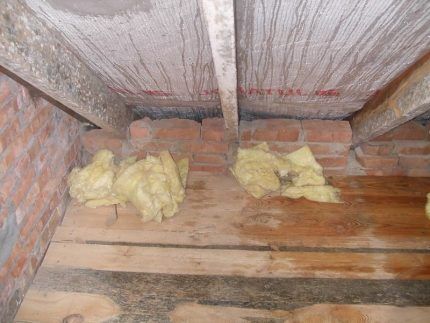
Of the entire range of thermal insulation materials, the most suitable for internal insulation of attics are mineral wool (basalt) and extruded polystyrene foam. Moreover, the first option is more preferable than the second. Mineral wool is not flammable and has better sound insulation.
You should not use glass wool because of its susceptibility to crumbling.Small glass particles are very dangerous for humans. And ordinary polystyrene foam is also not recommended for use in the attic. Compared to EPS, it is more flammable and environmentally harmful. In addition, it will have to be laid in a thicker layer.
Dew point problem
Ideally, the roof in the attic should be insulated from the outside at the stage of forming the roofing pie. However, often this is done the other way around from the inside, when the house is already covered with a roof. And here certain problems arise.
The correct and ideal roofing pie is several layers of different materials laid on top of the rafters tightly on top of each other without gaps. This sandwich ensures that Dew point will be located on its outer side. As a result, all condensate formed outside will quickly evaporate into the atmosphere.
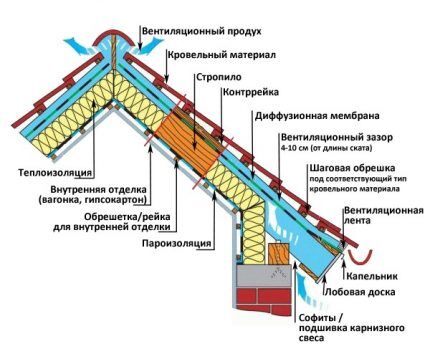
By doing insulation from the inside, after installing the roof, it is impossible to form the exemplary roofing pie described above. It will not be possible to press the insulation onto the roof so that there are no voids left between them.
But steam always moves towards cold air. And then, each of the formed cavities will begin to accumulate condensation and moisture. And this is a direct path to damage to the thermal insulation material and wooden elements of the rafter system.
When insulating an attic internally, the dew point has to be shifted into the space between the laid roof and the insulation, leaving an additional 5–10 cm gap there for ventilation.Only such a technology and such a cake will avoid moisture in the insulating material.
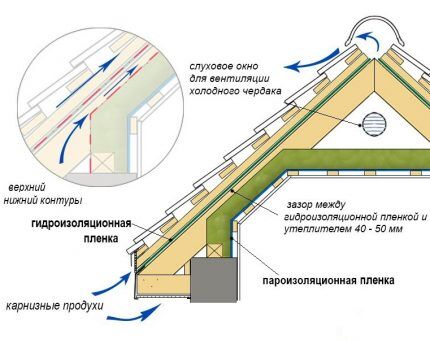
To reduce the amount of water vapor in the insulation, its installation should be done using a vapor barrier film. A vapor barrier is installed from the inside of the attic on top of the thermal insulation material.
The steam must first encounter this film and mostly remain in the room. The less of it gets into the insulation layer, the better.
Attic roof thermal insulation technology
To properly insulate the attic from the inside, you need to create a pie of five layers, starting from the roof inward:
- Ventilated air.
- Wind and moisture insulation from a vapor-permeable membrane.
- Insulation between rafters.
- Vapor barrier.
- Attic ceiling lining.
The vapor barrier is made from glassine, polyethylene or polypropylene film. The best option is special membranes, with one side rough and the other smooth. With these materials, the risk of condensation forming directly on them is reduced to almost zero.
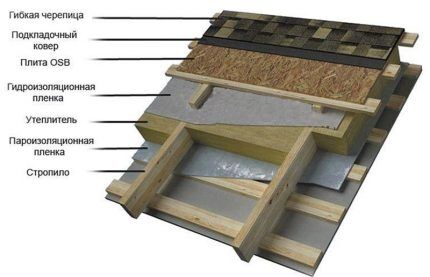
The following membranes are suitable for wind and moisture insulation:
- porous;
- two-layer film;
- three-layer superdiffusion;
- perforated.
Superdiffusion membranes last the longest and are the most effective. However, they are more expensive than other options.
At the same time, it is recommended to use perforated fabrics and films when insulating a residential attic only as a last resort. They are more designed for waterproofing cold sloping roofs in non-residential attics.
When installed with insulation in a warm room, these materials are often covered with frost in severe frosts, which reduces their vapor permeability to nothing.
Layer #1 - under-roof ventilation ducts
Before you start insulating the attic from the inside with your own hands, you first need to treat the wood of the rafters with antiseptics and fire retardants. Only then will it be possible to begin forming the thermal insulation cake.
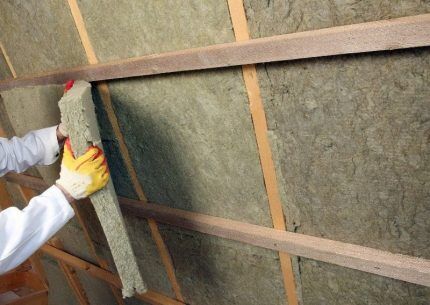
If you add insulation from the bottom of the rafters, the interior space of the attic will be reduced. The thickness of the thermal insulation cake often reaches 30–40 cm. If you subtract these centimeters from the top and sides, the room may turn out to be too low and small.
At the same time, the installation option with lining the sheathing under the rafters and laying insulation on it eliminates the appearance of cold bridges. If mineral wool or EPS is inserted between the beams, then they themselves and the gaps that form over time in the thermal insulation layer near them will draw heat from the attic.
In order for the ventilation in the under-roof space to comply with the requirements of SNiPs, deflectors or other openings for air outlet should be provided on the ridge.
The steam, along with the air currents, should rise to the highest point of the roof and leave from there completely outside.Moreover, this should happen without obstacles and as quickly as possible.
Before packing the membrane onto the rafters, you must first correctly calculate the thickness of the insulation. If the thermal insulation layer turns out to be larger than the size of the rafter beams, then you will have to build them up with bars. The main insulating material should be inside this frame and not protrude from it.
Layer #2 - vapor-permeable membrane
At the top of the formed under-roof pie there should be a material with high vapor permeability from the insulation to the street and high waterproofing in the opposite direction. The purpose of this membrane is not to prevent steam from escaping from the thermal insulation, while preventing water and moisture that can drip from a leaky roof from entering it.
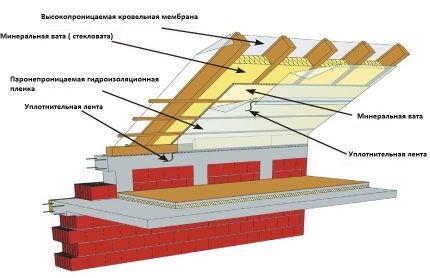
The best material for this vapor-permeable layer, which also performs the functions of wind and moisture protection, is superdiffusion membranes. They are not clogged with dust and ice formed from condensation in severe frosts.
Such membranes are laid in horizontal stripes with a 10–15 cm overlap of the top row onto the bottom row from the outside. The result should be a single canvas, so that if water drops hit it through the roof from the street, they would flow down without getting into the insulation.
The joints of the membrane rows from the inside of the attic are glued with mounting tape. It should be purchased under the same brand as the vapor-permeable film.
The composition of the adhesive and the membrane material from the same manufacturer are selected so as not to harm each other and remain reliably glued for many years.If you take them under different brands, then problems are possible.
Layer #3 - main insulation
The thickness of the insulation is selected in accordance with SNiP 02/23/2003. To do this, appropriate calculations are carried out, which take into account climatic conditions, the design and structure of the roof, as well as the characteristics of the thermal insulation material and the internal lining of the attic.

Manufacturers of thermal insulation provide instructions for the material they sell and post detailed recommendations on their official websites for determining this thickness. It is best to focus on these calculations.
Installation of insulation is carried out from the inside of the attic on top of a laid vapor-permeable membrane. If mineral wool is chosen, then it must be cut into pieces with dimensions 2–3 cm wider than the gaps between the rafters or sheathing bars. The mineral wool should fit between them with light pressure and stay there due to the spacer.
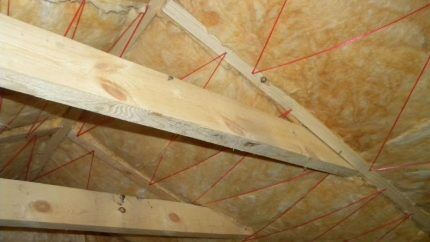
EPS will have to be laid on top of the rafters, and not between them. The slabs of this insulation are mounted end-to-end. If you put them inside the rafters, like mineral wool, then through holes will appear in the thermal insulation layer.
Some craftsmen fill such gaps with polyurethane foam from a balloon. However, you shouldn't do this. This can lead to membrane deterioration due to a chemical reaction between the components of the spray foam and the vapor-permeable film material.
It is better to take away 10-25 cm from the attic on top and on the sides for the sheathing with EPS, rather than getting a layer of protection with through holes.
Layer #4 - vapor barrier film
A vapor barrier made of glassine or polypropylene or polyethylene film should be laid on top of the insulation on the inside of the attic. The purpose of this layer is to prevent water vapor from entering the insulation from the room. It is laid in the same way as the very first vapor-permeable coating.
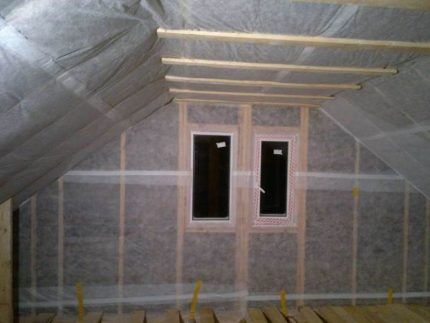
In addition to regular film, you can also use foil film. The extra layer of foil will reflect most of the heat energy back into the attic, reducing heating costs. In this case, the installation of such a film is carried out with “aluminum” inside.
The vapor barrier is fastened with staplers or nails with a wide head. And in places where the film adjoins cables, pipes and structural elements of roof windows, it should be additionally reinforced with a special one-sided tape with a heat-reflecting coating.
Layer #5 - Ceiling Sheathing
To complete the insulation of the attic, the sheathing is filled under the cladding. It is made from bars 15–25 mm thick so that there is a small ventilation gap above the vapor barrier.

The sheathing bars, on one side, are designed to fasten the sheathing material, and on the other, they additionally fix the vapor barrier membrane and press it against the insulation.
The sheathing itself can be painted or whitewashed.There are many options for finishing it. You can also avoid attaching plasterboard and chipboard at all, and just install clapboard on the sheathing.
A description of different methods of thermal insulation of an attic roof is presented in this article.
Conclusions and useful video on the topic
Overview of attic insulation technology:
Condensation due to improper vapor barrier and how to get rid of it:
When independently insulating the attic from the inside, when the roof is already covered, it is important to choose the right thickness of the insulating material. And even more important is to carry out the correct installation without breaking the vapor barrier and wind-moisture barrier.
If the protective films on both sides of the insulation have holes, then it will get wet and will no longer protect the house from the cold.
Do you have experience insulating an attic from the inside? Or want to ask questions on the topic? Please comment on the post, share your knowledge and participate in discussions. The feedback block is located below.




Good afternoon, I really need help insulating the attic. Don't know how to do it correctly? The roof is already covered, there is wind protection in the form of sugar bag material, is it possible to put insulation on it?